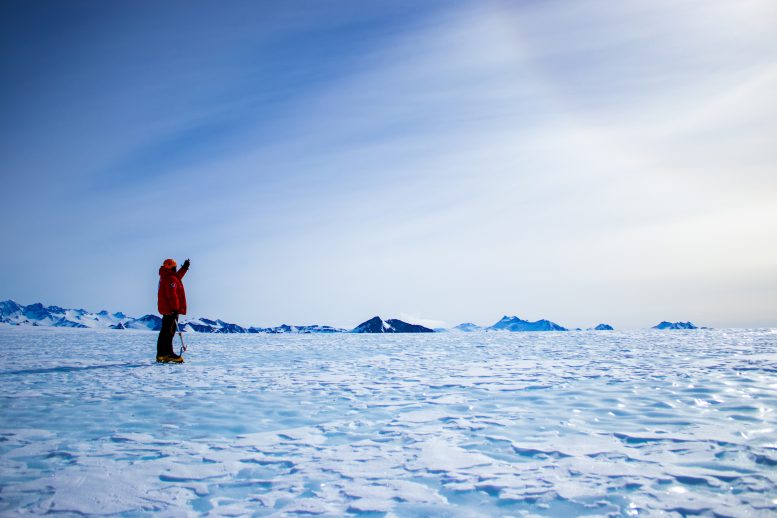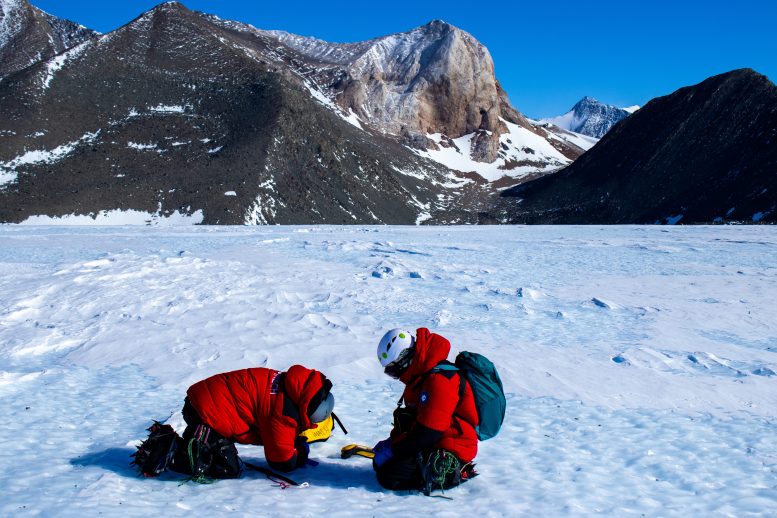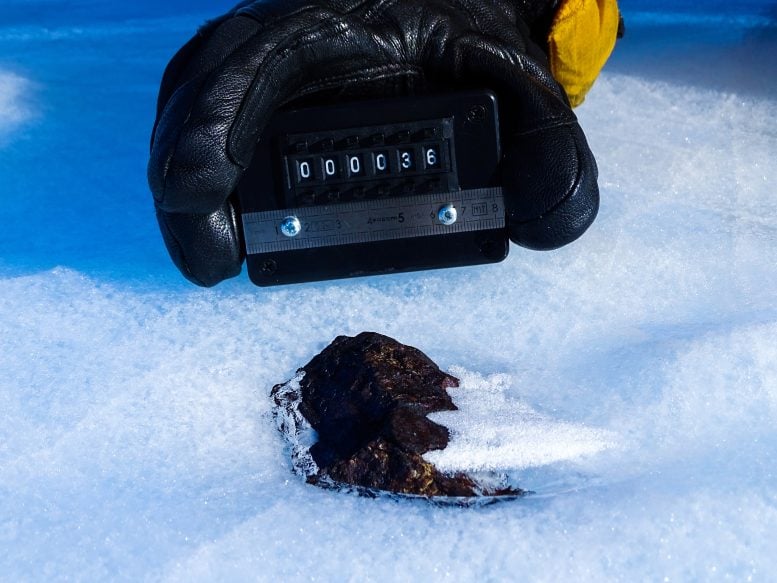
Field guide in a blue ice area during a mission to take ice samples. Photo taken during the 2023-2024 fieldwork mission of the Instituto Antártico Chileno (INACH) to Union Glacier, Ellsworth Mountains, Antarctica. Credit: Veronica Tollenaar, Université libre de Bruxelles
Using artificial intelligence, satellite observations, and climate model projections, a team of researchers from Switzerland and Belgium calculate that for every tenth of a degree of increase in global air temperature, an average of nearly 9,000 meteorites disappear from the surface of the ice sheet. This loss has major implications, as meteorites are unique samples of extraterrestrial bodies that provide insights into the origin of life on Earth and the formation of the Moon.
Disappearing at an alarming rate
By 2050, about a quarter of the estimated 300,000 – 800,000 meteorites in Antarctica will be lost due to glacial melt. By the end of the century, researchers anticipate that number could rise approaching a loss of meteorites closer to three-quarters of the meteorites on the continent under a high-warming scenario.

Ice sampling on a blue ice area in mountainous terrain. Photo taken during the 2023-2024 fieldwork mission of the Instituto Antártico Chileno (INACH) to Union Glacier, Ellsworth Mountains, Antarctica. Credit: Fernando Inostroza Méndez, Center for Antarctic Affairs of the Chilean Army. Credit: Veronica Tollenaar, Université libre de Bruxelles
Published in the journal Nature Climate Change, Harry Zekollari co-led the study while working under Professor Daniel Farinotti in the Laboratory of Hydraulics, Hydrology and Glaciology at the Department of Civil, Environmental and Geomatic Engineering at ETH Zurich. Zekollari and co-lead Veronica Tollenaar, Université Libre de Bruxelles, reveal in the study that ongoing warming results in the loss of about 5,000 meteorites a year, outpacing the collection efforts of Antarctic meteorites by a factor five.
Meteorites – time capsules of the universe
Zekollari, now an Associate Professor of Glaciology at Vrije Universiteit Brussel, calls for a major international effort to preserve the scientific value of meteorites, “We need to accelerate and intensify efforts to recover Antarctic meteorites. The loss of Antarctic meteorites is much like the loss of data that scientists glean from ice cores collected from vanishing glaciers – once they disappear, so do some of the secrets of the universe.”

Antarctic meteorite (HUT 18036) partially in the ice, in contrast to most samples that are collected while lying on the surface. Meteorite collected by the Lost Meteorites of Antarctica project. Credit: Katherine Joy, The University of Manchester, The Lost Meteorites of Antarctica project.
Meteorites are fragments from space that provide unique information about our solar system. Antarctica is the most prolific place to find meteorites, and to date, about 60 percent of all meteorites ever found on Earth have been collected from the surface of the Antarctic ice sheet. The flow of the ice sheet concentrates meteorites in so-called “meteorite stranding zones”, where their dark crust allows them to be easily detected. In addition to intensifying recovery operations, there is potential to increase the efficiency of meteorite recovery missions in the short term. This potential relies mainly on data-driven analysis to identify unexplored meteorite stranding zones and mapping areas exposing blue ice where meteorites are often found.
Extraterrestrial heritage slipping away
Due to their dark color, meteorites preferentially heat up with respect to the surrounding ice. As this heat transfers from the meteorites to the ice, it can warm up the ice, and eventually cause the ice to locally melt, leading to a sinking of meteorites underneath the surface of the ice sheet. Once the meteorites enter the ice sheet, even at shallow depths, they cannot be detected anymore, and they are thus lost to science.
As atmospheric temperatures increase, so does the surface temperature of the ice, intensifying the loss. “Even when temperatures of the ice are well below zero, the dark meteorites warm-up so much in the sun that they can melt the ice directly beneath the meteorite. Through this process, the warm meteorite creates a local depression in the ice and over time fully disappears under the surface,” says Tollenaar.
Scientists conclude that in the long-term, the only way to preserve most of the remaining unrecovered Antarctic meteorites is to rapidly reduce greenhouse gas emissions.
Reference: “Antarctic meteorites threatened by climate warming” by Veronica Tollenaar, Harry Zekollari, Christoph Kittel, Daniel Farinotti, Stef Lhermitte, Vinciane Debaille, Steven Goderis, Philippe Claeys, Katherine Helen Joy and Frank Pattyn, 8 April 2024, Nature Climate Change.
DOI: 10.1038/s41558-024-01954-y









“Once the meteorites enter the ice sheet, even at shallow depths, they cannot be detected anymore, and they are thus lost to science.”
Strange concern! More accurately, they can’t be seen readily. Metallic meteorites can be detected easily with a metal detector. Even many of the chondrites will have enough iron to be detectable through the clean ice. However, the contrast in conductivity and dielectric constant between the ice and chondrites should allow them to be detected with a specially designed sensor. What is ironic (pun intended) is that were it not for melting and sublimation, there would be no concentration of meteorites at the surface. Melting and sublimation concentrate the meteorites as the ice is removed and the meteorites move downward, perhaps making them more readily available in the future. The trick has always been to find them before they sink into the ice. Although, because chondrites have lower thermal conductivity, larger ones are more inclined to sit atop an ice pedestal than metallics:
https://www.antarctica.gov.au/site/assets/files/30502/balancing-act-near-rumddodle_-mawson-2016-17-03953.1200×0.jpg
I’m waiting for someone to claim that the “heartbreak of psoriasis” is caused by climate change.
“Under the high-emissions scenario (SSP5-8.5), 76% of the meteorites are lost by the end of this century and only 150 meteorite stranding zones (Methods) with an area of 3,180 km2 would remain, …”
There have been studies that strongly suggest that the “high-emissions scenario” is improbable because of inadequate reserves of fossil fuels.
The specimens are not “lost” forever. They remain below the surface at a depth where they don’t experience heating, much as they did prior to becoming the ‘surface’ from sublimation removing the ice. The question perhaps should be how long will they remain out of sight before once again being at the surface?